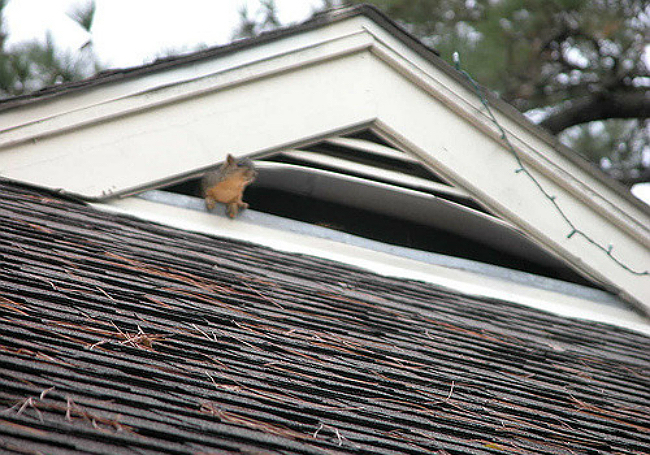

We may earn revenue from the products available on this page and participate in affiliate programs. Learn More ›
Q: I’ve suspected that animals are nesting in my attic for a while, and recently I’ve noticed lots of squirrel activity in the trees surrounding my roof. Is it possible that I have squirrels in my attic? And if I do, how do I make them leave?
A: While they may seem relatively harmless, squirrels can do a surprising amount of damage to a home if they are given the opportunity. Not only do squirrels in the attic damage siding and roofing materials to gain entry, but once inside they can damage insulation and even chew through electrical wiring. Many of the signs of squirrels in the attic are difficult to distinguish from those of other nuisance wildlife such as raccoons or mice, but seeing squirrels on the roof or nearby trees is a good indication that these are the critters you are dealing with. No matter the pest, animal activity in the attic is one house sound you don’t want to ignore.
Meg Pearson is a training manager at wildlife removal company Critter Control. “Squirrels, like most rodents, are known for their scurrying, so it can initially seem difficult to identify if you have a squirrel in your attic as opposed to a mouse or a rat,” she says. “Thankfully, there are some ways you can help discern which rodent you’re dealing with.”
Once squirrels are identified, natural deterrents, harassment methods, exclusion, or humane traps can sometimes be effective in getting rid of squirrels. Generally, though, it’s best to leave squirrel removal from the attic to professional wildlife removal services.
One of the most common signs of squirrels in the attic is a scratching, scurrying, or chewing noise.

Hearing skittering, scratching, or rolling noises from the ceiling is a pretty good indication that there is some kind of wildlife in the attic, but it may not necessarily be a squirrel. To pinpoint the type of pest, pay attention to when the commotion is occurring. Generally, squirrels are active during the day, so noises in the evening hours are more likely to come from nocturnal animals like rats and mice. If the strange sounds have occurred in the early spring or late summer, it might even be that a mother came to nurse her newborn squirrels in the attic and out of the elements. In that case, there may be as many as six squirrels in the attic including the mother, but they might leave on their own in a few weeks.
“The best way to discern which rodent is living in your attic is to take note of what time of day you hear their activity: squirrels are diurnal and do most of their scampering in the morning and during the day, while rats are nocturnal and do most of their scampering at night,” explains Pearson. “So, if you hear louder scurrying in the morning hours, you’re most likely dealing with a squirrel.”
Another common sign of squirrels in the attic is seeing paw prints near the attic entrance.
Looking for paw prints near the attic entrance can be an effective way to distinguish between squirrels and other animals. In some cases, paw prints may already be visible in snow, dirt, or dust on the roof’s surface. Otherwise, a simple way to capture paw prints is to sprinkle flour on a piece of cardboard and place it directly in the squirrels’ path near their suspected access point. If there is an active squirrel infestation in the attic, there will likely be tracks in the flour within a couple of days. Most squirrel tracks look like small feet and are around 1 to 1½ inches long. Alternatively, footprints double that size might belong to a raccoon, while mice prints are far smaller and rat tracks feature fine points created by their claws.
Squirrels love chewing, so seeing teeth marks is a common sign of a squirrel infestation.
It isn’t hard to imagine how squirrels’ large, distinctive front teeth might come in handy for chewing themselves an entrance into the attic. But it’s also worth noting that squirrels’ chewing behavior is not likely to stop there. Squirrels’ teeth grow continually throughout their lives, meaning they must consistently find things to gnaw on to wear them down. For squirrels in an attic, electrical wires are attractive for this purpose. At best, this can damage the home’s electrical system and cause power outages. At worst, exposed wires can lead to electrical fires and even electrocution. Those who have had a recent squirrel infestation in their attics will want to have an electrician inspect for damage to make sure the home’s wiring is still intact.
According to Pearson, “Squirrels cause lots of interior and exterior damage to homes. Their powerful teeth can gnaw through all sorts of materials, which can lead to expensive repairs. They also bring in debris to build nests for their forthcoming young and leave their droppings all around.”

Tried-and-True Advice
“I learned the hard way that squirrels can easily chew through standard plastic or lightweight mesh. I switched to ¼-inch hardware cloth and securely fastened it with screws and washers. That finally stopped them from getting back in.”
—Paul Rankin, Contributing Writer and Editor
Additional signs of squirrels in the attic include an unpleasant smell coming from the attic or air vents, water damage in the attic, and evidence of a nest.
Once squirrels have established a nest in the attic, squirrel droppings and urine may start to smell enough to be noticeable throughout the home, especially if the odor travels through the home’s HVAC system. Squirrels that have died in the attic may also start to smell within a couple of days. Since the squirrels must make a hole somewhere in the home’s exterior to enter, there may also be water damage from rain or snow, which can potentially lead to mold growth. The final telltale sign is finding squirrel nests around the attic. These nests can be made out of twigs, debris, insulation, or garbage.
Once you’ve confirmed the presence of squirrels, encourage them to evacuate by employing squirrel repellents and deterrents.
One way to get squirrels to leave an attic is to make the space unpleasant to them. A simple method is to place squirrel repellents in the attic such as ammonia or apple cider vinegar. Soaking rags in these substances and placing them around the attic often does the trick. Squirrels can also be deterred using sound. Placing a speaker in the attic and turning up the volume on a radio talk show or podcast may cause squirrels to think that humans are nearby and decide the space is unsafe. Finally, introducing bright or flashing lights and leaving them on throughout the day can also bother squirrels enough to make them seek shelter elsewhere.
“Squirrels are known to be non-aggressive, skittish critters, but if they feel threatened, they may bite someone, which can be quite painful, as they’re known for their very strong front teeth that they commonly use to bite through acorns and nuts,” warns Pearson. “Typically they will feel inclined to run away from humans, but if they’re stuck in an area where there’s nowhere to run, like an attic, they may feel the need to use their teeth.”
Evict squirrels from your attic using an exclusion device or a live-capture trap.
After tracking down the critters’ access point, it’s a good idea to install a one-way cage door or funnel just outside of it. Secured to the home’s exterior, these additions can catch squirrels on the way out of the attic for food or, in the case of funnels, allow them to leave but prevent return through the same hole. After setting up a live-catch trap, the homeowner will want to check the contraption twice daily and be prepared to relocate it to somewhere at least 3 miles away should it prove successful. All in all, using one of the best squirrel traps is one of the more effective and humane methods of squirrel in attic removal. That said, it’s important for a homeowner to check city, county, and state wildlife ordinances before proceeding with one of these measures to make sure they’re adhering to local laws and protocol. Some types of squirrels are protected in certain regions. In California, for example, it’s illegal to trap gray squirrels without a permit.
“Some homeowners may feel inclined to try their hand at removing a squirrel from their home themselves, before seeking out professional help,” says Pearson. This can be achieved sometimes by setting up cage traps in the areas that the squirrels frequent, but there is no guarantee of success.”
Discourage squirrels from moving into your attic by making your yard less attractive to them.
Squirrels seek out yards where they can find food and shelter, so limiting these elements may ultimately make them leave on their own. Cleaning up leaves and other kinds of debris gives squirrels fewer places to hide and find materials for their nests. Another way to deter squirrels is by spraying a liquid taste-based repellent on the lawn, soil, and trees to make the yard less inviting. Some plants and herbs, such as daffodils, peppermint, and garlic, are unpleasant to squirrels, so planting these may keep them at bay. If any tree branches hang over the roof, cutting them back can make it harder for other squirrels to crawl into the attic while the problem is being solved from within. And if there is a bird feeder in the yard, it can be squirrel-proofed by being placed on a baffle and stocked with white proso millet or safflower seeds, which are unpleasant to squirrels. Another idea is to sprinkle hot pepper in the bird seed, which is a natural squirrel repellent that is completely safe for birds. Finally, buying one of the best squirrel-proof bird feeders is another easy solution.
Seal attic openings and reinforce weak points to encourage squirrels to look elsewhere for shelter.
After removing squirrels from the attic, blocking off potential entry points can deter squirrels from entering again. If there is already an access point created by squirrels, it will need to be blocked or patched. Next, it’s a good idea to look for weak points such as rotting siding, loose singles, or damaged soffit and fascia and make repairs. Patching will need to be done with solid materials that animals will not be able to chew or scratch through. Metal flashing and chicken wire are typically effective options.
It’s also important to make sure that no squirrels are trapped in the attic before taking these steps. If there is a possibility that there is still at least one squirrel in the attic, it may be worth investing in a one-way door so that the squirrels can leave but won’t be able to get back in.
Call a professional to remove the squirrels from your attic if DIY methods have been unsuccessful.
In some lucky cases, natural deterrents or exclusion methods can be done by a resident, and they won’t have to spend a dime on squirrel removal costs. But if DIY methods don’t seem to be deterring squirrels, or a homeowner doesn’t feel comfortable with the prospect of coming into contact with squirrels in the attic, a wildlife removal technician will be able to take care of the problem with no trouble. In most cases, the cost of removing an animal from the attic is well worth it for the safety and peace of mind it provides. Wild animals, including squirrels, can be unpredictable, especially if they are protecting their young. According to the Humane Society, squirrels may also carry diseases like salmonella, so it’s important to use caution when coming close to them or their nests. Wildlife removal specialists will be able to assess an individual situation and determine how to get rid of squirrels safely and humanely. They’ll also be able to provide advice on keeping nuisance wildlife away in the future.
“Homeowners ought to seek out professional help sooner rather than later,” advises Pearson. “While squirrels may not seem like a particularly dangerous animal to have in your house, they can cause lots of interior damage very quickly. They chew and gnaw on almost anything they can, which can lead to expensive repairs. Most concerning, they are known to chew through electrical wiring which could bring about a seriously dangerous electrical fire. If you find a squirrel living in your home, it’s best to get a professional to handle it as soon as possible.”
